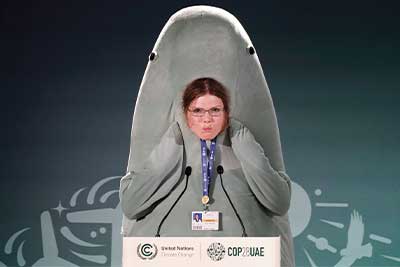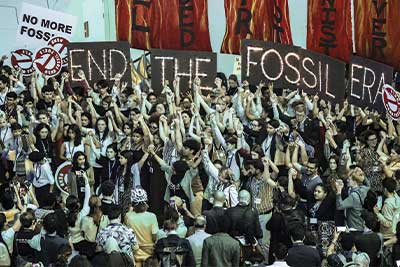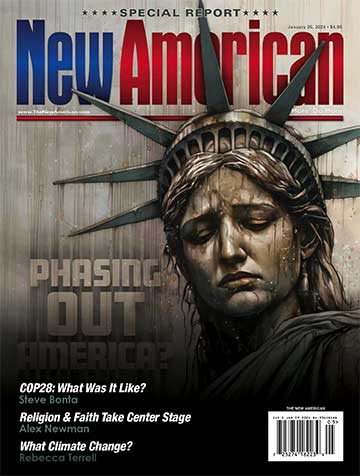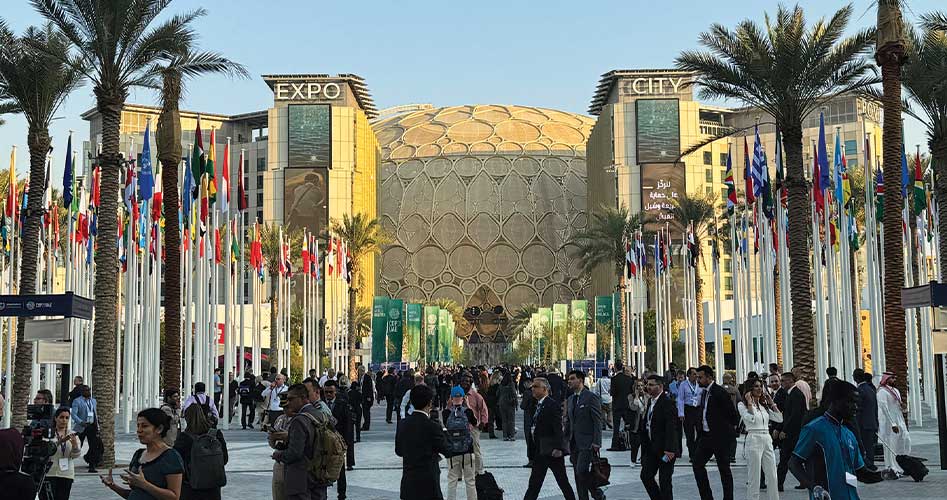COP28: What Was It Like?
Dubai — It’s been called the “Olympics of virtue signaling” for good reason. The annual UN Climate Conference, or COP (short for “Conference of the Parties” of the UNFCCC), attracts hundreds of global leaders, including presidents, prime ministers, and monarchs, to some swank resort or similar venue. Alongside the besuited wealthy elites in their private jets come thousands of left-wing activists ranging from respectable-seeming NGO delegates, to noisy, ultra-radical street agitators, to representatives of aboriginal cultures. And mingling with the agenda-setters are thousands of journalists, representing everything from establishment “newspapers of record” and major news channels to environmental news aggregators and blogs.
This superficially discordant crowd with its manufactured “booming, buzzing confusion” has convened almost every year for more than three decades, and despite the appearance of heterogeneity, almost everyone present agrees wholeheartedly with the broad mission: to save the planet Earth from man-made climate catastrophe. And while the annual antics at the climate conferences may appear to be more spectacle than substance, the radical global movement to dismantle modern civilization in the name of saving the climate has become a clear and present danger to national sovereignty and to civilizational progress.
December’s UN climate conference, COP28, was the most ambitious yet (and given the previous year’s COP27 landmark agreement on loss and damage payments, that’s saying something). Held at the sprawling Expo City in sumptuous Dubai, COP28 benefited from the enormous wealth and other resources of the host country, and the tone at the event was shriller and more insistent than previous such events. As with every global climate conference stretching all the way back to Rio de Janeiro in 1992, this year’s event featured the usual amalgam of global elites (including a delegation of U.S. senators and even, for a brief interval, Vice President Kamala Harris) and corporate special interests, along with a motley array of NGOs, including outrageously costumed environmental activists and representatives of indigenous people decked out in colorful attire. There was anticipation among the thousands of globalist activists and policymakers who descended on Dubai that the years of slowly tightening strangulation of the world’s economy and political system by the global climate regime is about to enter a new, much more ambitious phase. The “energy transition,” as it’s called, whereby the human race will be forced to repudiate centuries of technological progress and unfettered economic growth in order to appease the guardians of the planet, has reached the breakout point. Or so we were told, over and over.
From the raucous beginnings at Rio that provoked a mostly bemused reaction from any rational minds paying attention, the climate crusade has evolved into a deadly serious threat, perhaps the gravest danger to American sovereignty and individual liberty yet to emanate from the United Nations system. And, unless things change in a hurry, the climate crusaders are going to literally tear down modern Western civilization, along with all the individual freedoms and standard of living it entails.
Outlandish Objectives
First, the objectives of this year’s event. Heading the list of agenda items was extracting a firm agreement on commencing the flow of loss and damage payments from the wealthy to the poor countries, beginning in 2025. This is to be a heavy, permanent regime of international wealth transfer from the haves to the have-nots, on a breathtaking scale that probably far exceeds Karl Marx’s wildest fever dreams. There’s a reason why attendees at COP28 were demographically skewed, with Sub-Saharan Africa, Latin America, Oceania, and the poorer Asian countries represented out of proportion to actual population, while Japanese, Europeans, and North Americans were decidedly underrepresented. These are the countries that will be fleeced by the rest, and the intended beneficiaries, lacking the economic, political, or military clout to compel the developed world to heel, have been on a sustained campaign to shame, manipulate, and otherwise take advantage of Westerners’ compassion. Everything wrong with the world, it turns out, is the fault of Western countries, and only loss and damage tribute can atone for their collective guilt.
An even more quixotic and irrational goal, broadcast far and wide during the two weeks of the conference and amplified worldwide by the breathlessly sycophantic leftist establishment media, was the complete phaseout of all fossil fuels within a few years, beginning with the industrialized countries whose economies most critically depend on them. The so-called reasoning behind this objective is to keep global temperature increases within the rather arbitrary limit of 1.5 degrees Celsius. More than that, we were warned again and again, the Earth will enter a period of runaway and irrevocable climate change featuring cataclysmic glacier melting and, in the longer run, boiling oceans. Throughout the conference, the catchphrase “Keep 1.5 alive” served to remind one and all of how stark the stakes were.
Given the goal of fossil-fuel eradication, it seemed incongruous to hold such a conference in the petroleum-rich sands of the United Arab Emirates (UAE), just miles from some of the world’s most extensive petroleum and natural-gas extraction and refining facilities. The president of this year’s climate conference, Emirati Sultan Ahmed Al Jaber, triggered outraged headlines several days into the conference with comments he made questioning the science behind a fossil-fuel phaseout. The sultan, unlike many other globe-trotting elites at the conference, was a relatively accessible presence at many press conferences and conference sessions open to the public. In fact, many white-robed sheikhs were involved in the proceedings, picking their way disdainfully through the loutish mob of Western leftist activists that maintained a constant presence at every venue where the People Who Mattered convened.
To say that the Emiratis, conservative Muslims all, had difficulty comprehending the secularized furor that is radical Western environmentalism would be an understatement. Beneath the veneer of Westernized modernity evident across the UAE is a deeply conservative, devout society for whom secular Earth worship and moral relativism are utterly incompatible with the worldview of the Faithful. Moreover, the UAE, despite its federal structure, is neither democratic nor a republic. It’s an Islamic monarchy where criticism of the government and Islam alike is strictly prohibited, and the sort of boisterous street demonstrations from which climate conferences typically channel much of their energy were nonexistent. But even without the street mummery, COP28 must have seemed to most Emiratis as deeply disruptive and emblematic of the worst excesses of the secular West.
Dugong show: Dressed as a sea cow, California activist Alice McGown earned points for originality, if not rationality, at COP28. Here, McGown addresses a supposedly serious session in full sirenian splendor. (AP Images)

Not that the UAE, despite its immense industrial and financial base, is lacking in a conservationist ethic. The Arabian Desert is one of the bleakest and least biodiverse places on Earth; indeed, the southern part of the UAE blends into the Rub’ al Khali, or Empty Quarter, a region of desert so hot and dry that none of the four countries that border it — Oman, Saudi Arabia, and Yemen being the other three — care enough about it even to establish settled international boundaries. Yet in spite of these environmental limitations, the Emiratis have managed to make the desert bloom, to some degree. The city of Dubai itself boasts a large wildlife sanctuary, Ras al Khor, that hosts hundreds of flamingoes and other wading birds, while in the desert not far from the Expo City where COP28 was held, the gigantic Al Marmoom Desert Conservation Area harbors significant herds of Arabian oryx and wild gazelles, as well as numbers of wintering eagles and other birds. An enormous nearby chain of artificial lakes and wetlands, the Al Qudra Lakes, teems with waterfowl. In both of these areas camping, bicycling, and hiking are enduringly popular among Emiratis. Given the amount of desalinized seawater needed to maintain such areas, the UAE, like the developed West, has reached a level of prosperity where it can afford to maintain parks and sanctuaries, and to place limits on hunting and fishing. But other, poorer Middle Eastern countries enjoy no such luxury; to them, and to many other poor countries across the Global South, the goal of eliminating fossil fuels and all of the technology they enable must have seemed preposterous. But for the sake of the former goal — the anticipated global shakedown — they were willing to play along with the show.
The Greatest Sham on Earth
And what a show it was. Whatever else may be said about radical leftists, it must be admitted that they have a flair for the dramatic. Daily protests, prohibited outside conference grounds and severely restricted within, provided the usual make-believe spontaneity of street activism, the “pressure from below” staking out the most extreme positions possible. These colorful minions sported everything from extravagant native feathered headpieces to animal costumes. One lady attracted international attention by wearing a manatee costume, a departure from the usual sea turtle apparel. Most of the protests that I observed took place around lunchtime, and consisted of raucous chants accentuated by drum beating, followed by a march of a few hundred yards from one side of the “blue zone” to the other.
All of the protests, of course, were designed to put pressure on conference delegates from the Left, and were exclusively sympathetic to radical climate politics. No dissenting protests, such as voices questioning the entire histrionic climate narrative, were permitted. The press reports were full of rhetorical finger-wagging at the UAE government for clamping down on the “free speech” of protesters; no one noted the irony that COP28 itself permits no dissenting voices to be raised. Even the occasional adversarial question by some independent journalist such as my colleague Alex Newman was viewed with hostility. From what I could observe, an overwhelming majority of the thousands of journalists present were leftist sycophants as concerned with advancing the conference’s agenda as the conference delegates themselves.
This, then, was the scene within the “blue zone,” the elite decision-making area accessible only to those, including yours truly, with coveted credentials. Outside the blue zone, and almost completely encircling it, was the sprawling “green zone,” where the general public could visit and be indoctrinated. Near one of the entrances, employees of the event actively encouraged passersby to enter a large, postmodern-looking building, the Mobility Pavilion, that resembled a stack of silver trefoils. Inside the building was a lavish, high-tech, interactive tour of the world of the future that tried to portray the goings-on at COP28 as both the outgrowth of millennia of enlightened progress and as the gateway to a still more enlightened and advanced future. With a sophistication rivaling that of a major theme park, the presentations included fawning portrayals of high Islamic culture complete with enormous statues of several notable Muslim sages of centuries past, as well as a history of the creation of the UAE itself. Following these were dazzling light shows designed to portray the future of world climate, the future of AI, and the future of technology in general. The overall effect was to instill awe and (for the locals, at any rate) sympathy for a cause that supposedly resonated with the values of Emirati and Islamic culture.
The Mobility Pavilion was the propaganda centerpiece of the entire event, as evidenced by the fact that this author was asked to enter and view the program every time he walked past! Across from the Mobility Pavilion was what looked to be at first blush a sort of indoor trade fair. But the booths that lined the interior of the gymnasium-like building were all corporate advertisements for the green policies of a veritable Who’s Who of prominent multinational corporations. IBM, Microsoft, and many other major players had lavish displays detailing their slavish compliance with the global green regime, with sober-looking delegates participating in various public meetings and presentations.
And so it went, building after building brimming with green propaganda, eyewash for the thousands of non-official visitors from both Dubai and abroad.
For those of us involved in events, the UN organizers sent a steady flow of detailed emails updating us on the status of negotiations and apprising us of major upcoming events such as press conferences and public meetings with major dignitaries present. Once the novelty of the occasion wore off, however, every event seemed more or less the same. No matter the theme, the rhetoric and talking points were always drearily predictable: Technology and progress are bad. The planet is on the brink of climate cataclysm. Only 1.5 Celsius can save us. The rich countries are morally culpable for progress, and must begin handing over their ill-gotten gains to the Global South. The “energy transition” is inevitable. And above all else, the United States is to blame for everything and must be held to account for its transgressions.
Equally striking was the way in which everything was portrayed as being associated with climate issues. The wars in Gaza and Ukraine? These and other conflicts are consequences of instability wrought by climate change. AI? It must be used to advance the message of climate alarmism more effectively. Global finance? We have to ensure that all finance and banking is compliant with the Paris climate treaty. To the true believers at COP28, literally everything is subsumed by the climate, and impacted by man’s alleged alteration thereof.

Fossil furor: One of the many choreographed demonstrations at COP 28 expressing mindless opposition to fossil fuels. Although the climate conference failed to commit to its main goal, the total phaseout of fossil fuels, radical Left support of this measure will continue. (AP Images)
Step by Step
In the end, of course, the event fell short of its most radical and most stridently proclaimed objective; despite two weeks of virtue signaling, posturing, and threats (“We aren’t leaving without a deal”), the not-so-august assembly broke up without a commitment to phase out fossil fuels. The tens of thousands of attendees returned disappointed in the outcome, unalterably convinced that the planet is on a climatic doom loop, and resolved to try again a year from now. My own flight to Frankfurt was crammed with them, and it was obvious from overheard conversation that this was an annual outing for many of them. Undeterred by the incongruity of choosing a major producer of fossil fuels to host an event consecrated to the ending of fossil-fuel extraction, COP planners announced just before the close of the conference that next year’s event would be held in another major oil country, Azerbaijan, which is the world’s 24th-largest oil producer.
And while it didn’t meet its most ambitious goal, the conference did lead to an agreed-upon timetable for the beginning of loss and damage payments, thereby guaranteeing that the Samoas, Maldives, and Central African Republics of the world will not go empty-handed. The United States, meanwhile — unless there is an electoral rout next year — will commence the heavy new tributary payments in the near future.
And, of course, a year from now, the UN’s green gestapo will have another shot at fossil fuels.


